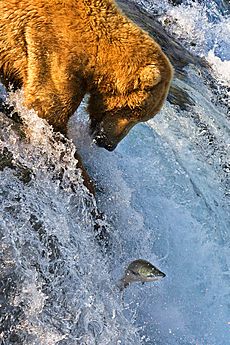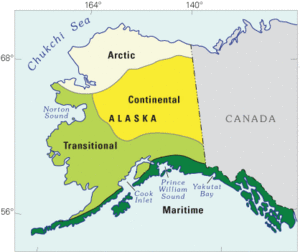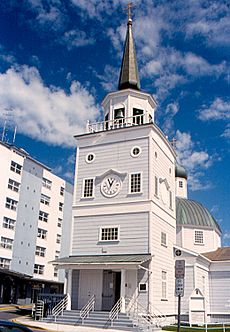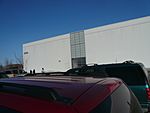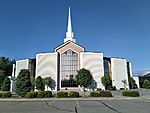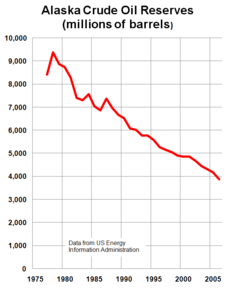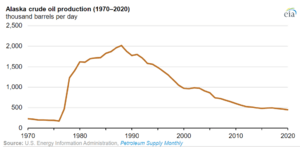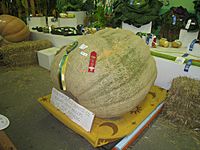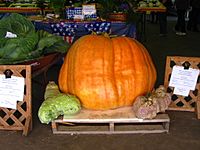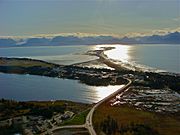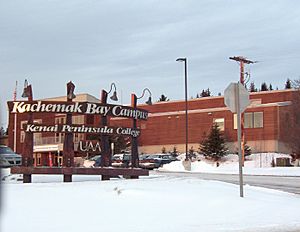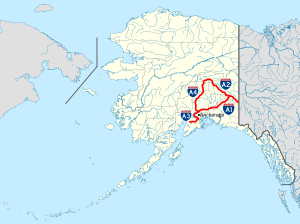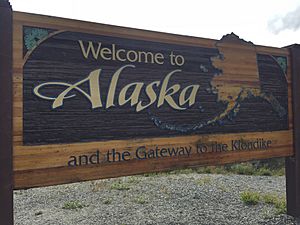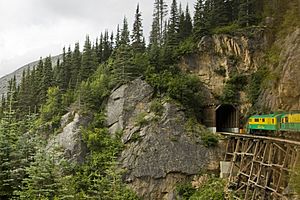Alaska facts for kids
Quick facts for kids
Alaska
|
|||
|---|---|---|---|
|
|||
| Nickname(s):
The Last Frontier
|
|||
| Motto(s):
North to the Future
|
|||
| Anthem: Alaska's Flag |
|||
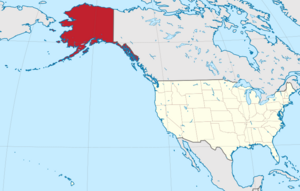
Location of Alaska within the United States
|
|||
| Country | United States | ||
| Before statehood | Territory of Alaska | ||
| Admitted to the Union | January 3, 1959 (49th) | ||
| Capital | Juneau | ||
| Largest city | Anchorage | ||
| Largest metro and urban areas | Anchorage | ||
| Legislature | Alaska State Legislature | ||
| • Upper house | State Senate | ||
| • Lower house | House of Representatives | ||
| Judiciary | Alaska Supreme Court | ||
| U.S. senators |
|
||
| U.S. House delegation | Nick Begich III (R) (list) | ||
| Area | |||
| • Total | 665,384 sq mi (1,723,337 km2) | ||
| • Land | 586,412 square miles sq mi (1,518,800 km2) | ||
| • Water | 91,316 sq mi (236,507 km2) 13.77% | ||
| Area rank | 1st | ||
| Dimensions | |||
| • Length | 1,420 mi (2,285 km) | ||
| • Width | 2,261 mi (3,639 km) | ||
| Highest elevation
(Denali)
|
20,310 ft (6,190.5 m) | ||
| Lowest elevation | 0 ft (0 m) | ||
| Population
(2024)
|
|||
| • Total | |||
| • Rank | 48th | ||
| • Density | 1.10/sq mi (0.42/km2) | ||
| • Density rank | 50th | ||
| • Median household income | $86,600 (2023) | ||
| • Income rank | 12th | ||
| Demonym(s) | Alaskan | ||
| Language | |||
| • Official languages | Ahtna, Alutiiq, Dena'ina, Cup'ig, Deg Xinag, English, Eyak, Gwich'in, Haida, Hän, Holikachuk, Inupiaq, Koyukon, Lower Tanana, Middle Tanana, St. Lawrence Island Yupik, Tanacross, Tlingit, Tsimshian, Unangax̂, Upper Kuskokwim, Upper Tanana, Yup'ik, Wetał | ||
| • Spoken language |
|
||
| Time zones | |||
| east of 169°30' | UTC−09:00 (AKST) | ||
| • Summer (DST) | UTC−08:00 (AKDT) | ||
| west of 169°30' | UTC−10:00 (HST) | ||
| • Summer (DST) | UTC−09:00 (HDT) | ||
| USPS abbreviation |
AK
|
||
| ISO 3166 code | US-AK | ||
| Latitude | 51°20'N to 71°50'N | ||
| Longitude | 130°W to 172°E | ||
| Bird | Willow ptarmigan |
|---|---|
| Fish | King salmon |
| Flower | Forget-me-not |
| Tree | Sitka Spruce |
| Insect | Four-spot skimmer dragonfly |
| Sport | Dog mushing |
Alaska ( Aleut: Alax̂sxax̂; Inupiaq: Alaasikaq; Alutiiq: Alas'kaaq; Yup'ik: Alaskaq; Tlingit: Anáaski) is a state in the Western United States. It is located at the very northwest tip of North America. Alaska shares a border with British Columbia and Yukon in Canada. It also has a water border with Russia across the Bering Strait. To the north are the Arctic Ocean's Chukchi and Beaufort seas. The Pacific Ocean is to the south and southwest.
Alaska is the largest U.S. state by far. It is bigger than the next three largest states (Texas, California, and Montana) combined. Even though it is huge, Alaska has one of the smallest populations. It is also the most spread out state. About half of Alaska's people live near Anchorage. The capital city, Juneau, is one of the largest cities in the U.S. by area. It is even bigger than the states of Rhode Island and Delaware.
Native people have lived in Alaska for thousands of years. Many believe this area was the first entry point for people coming to North America. This happened over the Bering land bridge. In the 1700s, the Russian Empire started to settle the area. They created Russian America. Later, in 1867, the U.S. bought Alaska from Russia for US$7.2 million. This was about two cents per acre. Alaska became a U.S. territory in 1912. It officially became the 49th U.S. state on January 3, 1959.
Alaska's economy is smaller than many other states. However, its people have a high average income. This is because of its strong industries like fishing, natural gas, and oil. Alaska has a lot of these natural resources. U.S. military bases and tourism are also very important to Alaska's economy. More than half of the state is public land owned by the government. This includes many national forests, national parks, and wildlife refuges.
Alaska has the highest percentage of indigenous people of any U.S. state. Over 15 percent of the population are Native Alaskans. They speak almost two dozen native languages. Native Alaskans have a big impact on local and state politics.
Contents
- Exploring Alaska's Vast Geography
- A Brief Look at Alaska's History
- How Alaska's Government Works
- People and Languages of Alaska
- Alaska's Economy and Resources
- Cities, Towns, and Boroughs
- Alaska's Culture and Traditions
- Learning in Alaska: Education
- Getting Around: Transportation in Alaska
- Alaska's State Symbols
- Images for kids
- See also
Exploring Alaska's Vast Geography

Alaska is the northernmost and westernmost state in the United States. It even has the most easterly longitude because some of the Aleutian Islands reach into the Eastern Hemisphere. Alaska is the only U.S. state on mainland North America that is not connected to the other states. About 500 miles (800 km) of British Columbia (Canada) separates Alaska from Washington.
The state is bordered by Yukon and British Columbia in Canada to the east. To the south and southwest are the Gulf of Alaska and the Pacific Ocean. The Bering Sea, Bering Strait, and Chukchi Sea are to the west. The Arctic Ocean is to the north. Alaska's waters are very close to Russia's in the Bering Strait. The Russian Big Diomede Island and Alaska's Little Diomede Island are only 3 miles (4.8 km) apart. Alaska has a longer coastline than all other U.S. states put together.
Alaska is the largest state in the United States by land area. It is over twice the size of Texas. Alaska is larger than all but 18 countries in the world. If you count its water areas, Alaska is bigger than Texas, California, and Montana combined. It is also larger than the combined area of the 22 smallest U.S. states.
What Are Alaska's Main Regions?
Alaska does not have official borders for its regions. However, there are six commonly known areas:
South Central Alaska: Where Most People Live
This is the most populated part of Alaska. It includes Anchorage, the Matanuska-Susitna Valley, and the Kenai Peninsula. This area also has wild, unpopulated lands south of the Alaska Range and west of the Wrangell Mountains. The Prince William Sound area, with towns like Cordova and Valdez, is also here.
Southeast Alaska: The Panhandle
This region is also called the Panhandle or Inside Passage. It is the part of Alaska closest to the rest of the United States. Many early settlers came here after the Alaska Purchase. The area has many islands, called the Alexander Archipelago. It is also home to the Tongass National Forest, which is the largest national forest in the U.S. The state capital, Juneau, is in this region. The former capital, Sitka, and Ketchikan are also here. The Alaska Marine Highway ferry system is very important for travel in this area. Only three towns (Haines, Hyder, and Skagway) are connected to the North American road system.
Interior Alaska: Home to Denali
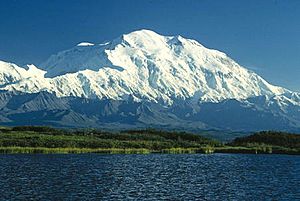
The Interior is the largest region of Alaska. Much of it is wild and empty. Fairbanks is the only big city in this area. Denali National Park and Preserve is located here. Denali is the highest mountain in North America.
Southwest Alaska: Wild Coastlines
Southwest Alaska is a very spread-out region. It stretches about 500 miles (800 km) inland from the Bering Sea. Most people live along the coast. Kodiak Island is also in this region. The huge Yukon–Kuskokwim Delta, one of the world's largest river deltas, is found here.
North Slope: Oil and Tundra
The North Slope is mostly tundra with small villages. This area is famous for its huge oil reserves. It includes the National Petroleum Reserve–Alaska and the Prudhoe Bay Oil Field. Barrow, the northernmost city in the United States, is located here.
Aleutian Islands: Volcanic Chain
More than 300 small volcanic islands make up this chain. They stretch over 1,200 miles (1,900 km) into the Pacific Ocean. Some of these islands are actually in the Eastern Hemisphere. However, the International Date Line was moved to keep all of Alaska on the same day. Two islands, Attu and Kiska, were taken over by Japanese forces during World War II.
Amazing Natural Features of Alaska

Alaska has nearly 34,000 miles (54,720 km) of coastline with many islands. Many active volcanoes are found in the Aleutian Islands and along the coast. For example, Unimak Island has Mount Shishaldin. This volcano sometimes smokes and rises 10,000 feet (3,048 m) above the North Pacific. It has a perfect cone shape, even more perfect than Japan's Mount Fuji.
One of the world's largest tides happens in Turnagain Arm, south of Anchorage. The water level can change by more than 35 feet (10.7 m).
Alaska has over three million lakes. Marshlands and frozen ground (called permafrost) cover 188,320 square miles (487,747 km2). This is mostly in the flat northern, western, and southwestern areas. Glacier ice covers about 16,000 square miles (41,440 km2) of land. Alaska has over 100,000 glaciers, which is half of all the glaciers in the world.
Understanding Alaska's Climate Zones
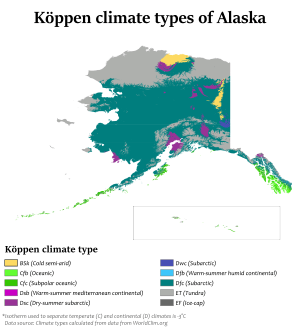
The climate in Southeast Alaska is mild and wet. It has warmer winters and a lot of rain all year.
The climate in Anchorage and south central Alaska is milder than other parts of the state. This is because it is close to the ocean. It gets less rain but more snow than Southeast Alaska.
The climate of Western Alaska is shaped by the Bering Sea and the Gulf of Alaska. It is somewhat moderate for how far north it is.
Interior Alaska has a subarctic climate. This means long, cold winters and short, cool summers.
The very northern part of Alaska has an Arctic climate. It has very long, very cold winters and short, cool summers.
A Brief Look at Alaska's History
Becoming a State: A Journey to the 49th Star
Becoming a state was a big goal for Alaska. The idea gained real support after a vote in 1946. Alaska officially became the 49th U.S. state on January 3, 1959.
The Great Alaska Earthquake of 1964
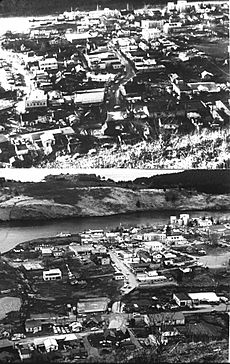
On March 27, 1964, a huge earthquake hit Alaska. It was called the Good Friday earthquake. It killed 133 people and destroyed many villages and parts of coastal towns. This was mainly due to the tsunamis and landslides it caused. It was the second-most powerful earthquake ever recorded in the world. Its strength was 9.2 on the moment magnitude scale. It was over a thousand times stronger than the 1989 San Francisco earthquake. The time of day (5:36 pm) and year helped save many lives, especially in Anchorage.
How Alaska's Government Works
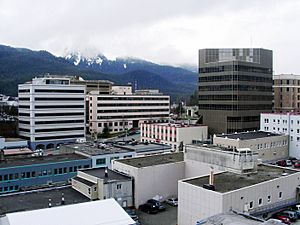
Like all other U.S. states, Alaska has a government with three main parts. These parts work together to run the state.
- The executive branch includes the governor of Alaska and their team. They lead state departments.
- The legislative branch makes laws. It has the Alaska House of Representatives and the Alaska Senate.
- The judicial branch includes the Alaska Supreme Court and other courts. They interpret laws and handle legal cases.
The Alaska State Legislature has 40 members in the House of Representatives and 20 members in the Senate. Senators serve four-year terms, and House members serve two-year terms. The governor of Alaska serves four-year terms.
Alaska's court system has four levels. These are the Alaska Supreme Court, the Alaska Court of Appeals, the superior courts, and the district courts. The superior and district courts handle trials. The Supreme Court and Court of Appeals handle appeals.
People and Languages of Alaska
| Historical population | |||
|---|---|---|---|
| Census | Pop. | %± | |
| 1880 | 33,426 | — | |
| 1890 | 32,052 | −4.1% | |
| 1900 | 63,592 | 98.4% | |
| 1910 | 64,356 | 1.2% | |
| 1920 | 55,036 | −14.5% | |
| 1930 | 59,278 | 7.7% | |
| 1940 | 72,524 | 22.3% | |
| 1950 | 128,643 | 77.4% | |
| 1960 | 226,167 | 75.8% | |
| 1970 | 300,382 | 32.8% | |
| 1980 | 401,851 | 33.8% | |
| 1990 | 550,043 | 36.9% | |
| 2000 | 626,932 | 14.0% | |
| 2010 | 710,231 | 13.3% | |
| 2020 | 733,391 | 3.3% | |
| 2024 (est.) | 740,133 | 4.2% | |
| 1930 and 1940 censuses taken in preceding autumn Sources: 1910–2020 |
|||
In 2020, the population of Alaska was 733,391 people. This was a 3.3% increase since 2010. Alaska ranks as the 48th largest state by population. Only Vermont and Wyoming have fewer people. Alaska is the least densely populated state. This means people are very spread out.
Who Lives in Alaska?
In 2019, about 60% of Alaska's population was non-Hispanic white. About 15.6% were American Indian or Alaska Native. Other groups include Asian (6.5%), Black or African American (3.7%), and Native Hawaiian and other Pacific Islander (1.4%). About 7.5% of the population identified as two or more races. Around 7.3% of people were Hispanic or Latin American.
Languages Spoken in Alaska
Most people in Alaska speak English at home. In 2019, about 83.7% spoke only English. About 4.0% spoke Spanish. Around 5.6% spoke Asian and Pacific Islander languages.
Alaska has 20 indigenous languages. These are also called "native languages." About 5.2% of Alaskans speak one of these languages. Most of these languages are either threatened or nearly extinct.
In 2014, Alaska's governor signed a bill. This bill made the state's 20 indigenous languages official. This was a symbolic step to recognize them.
Here are some of the official indigenous languages:
- Inupiaq
- Siberian Yupik
- Central Alaskan Yup'ik
- Alutiiq
- Unangax
- Dena'ina
- Deg Xinag
- Holikachuk
- Koyukon
- Upper Kuskokwim
- Gwich'in
- Tanana
- Upper Tanana
- Tanacross
- Hän
- Ahtna
- Eyak
- Tlingit
- Haida
- Tsimshian
Religion in Alaska
In 2014, about 62% of adults in Alaska practiced Christianity. Protestantism was the largest Christian group. The Catholic Church was the largest single Christian group.
Many people in Alaska do not identify with a specific religion. They make up the largest non-Christian group. Atheists made up 5% of the population. The largest non-Christian religion was Buddhism.
The first Russian Orthodox Church was built in Kodiak in 1795. Many Russian Orthodox churches were built in Alaska over time. Alaska also has the largest percentage of Quakers of any state.
In 2010, Alaskan Hindus built the Sri Ganesha Temple of Alaska. This was the first Hindu Temple in Alaska. It is the northernmost Hindu Temple in the world. There are an estimated 2,000–3,000 Hindus in Alaska. Most live in Anchorage or Fairbanks.
Estimates for Muslims in Alaska range from 2,000 to 5,000. The Islamic Community Center of Anchorage built the first mosque in the state. It is one of the northernmost mosques in the world.
Alaska's Economy and Resources
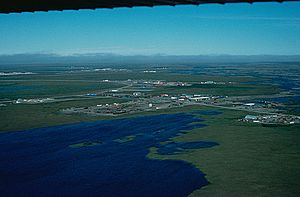
Alaska's economy is heavily based on oil and gas. More than 80% of the state's money comes from taking out petroleum. Alaska's main export (besides oil and natural gas) is seafood. This includes salmon, cod, Pollock, and crab.
Farming is a very small part of Alaska's economy. Most food is grown for people to eat within the state. This includes vegetables, dairy products, and livestock. Most manufactured goods and food are brought in from other places.
Many jobs are in government and industries like natural resource extraction, shipping, and transportation. Military bases are also a big part of the economy in some areas. The U.S. government gives money to Alaska. This helps the state keep taxes low. Alaska also has a growing service and tourism industry. Tourists help the economy by staying in local hotels and buying things.
Alaska's Energy Resources
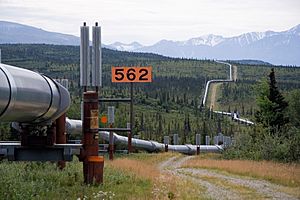
Alaska has huge energy resources. Large oil and gas reserves were found in the Alaska North Slope and Cook Inlet. However, Alaska's oil production has decreased over time. The Prudhoe Bay Oil Field is still a very high-yielding oil field in the United States.
The Trans-Alaska Pipeline can move up to 2.1 million barrels (330,000 m3) of crude oil per day. This is more than any other crude oil pipeline in the U.S. Alaska also has a lot of coal. The United States Geological Survey thinks there are huge amounts of natural gas hydrates in the Alaskan North Slope. Alaska also has high potential for hydroelectric power from its many rivers. The coastline offers wind and geothermal energy potential.
Alaska's economy relies a lot on diesel fuel for heating, transport, and electricity. Fuel prices are often higher in Alaska than in the rest of the U.S.
The Alaska Permanent Fund: Sharing Oil Money
The Alaska Permanent Fund was created in 1976. It is a special fund that holds some of the state's oil money. This fund was set up to manage extra money from oil. It was meant to make sure the money was not spent all at once.
The fund has grown to $50 billion from oil money and investments. Most of this money is invested outside Alaska.
Since 1982, money from the fund's growth has been paid out each year to eligible Alaskans. This payment is called the Permanent Fund Dividend. To get this payment, you must have lived in Alaska for at least 12 months. You also need to keep living there and not have certain criminal convictions.
Cost of Living in Alaska
Things cost more in Alaska than in the other 48 states. Federal workers in Alaska get extra money for this higher cost of living.
In rural Alaska, food and goods are very expensive. This is because it is hard to transport things to these areas. The cost of transport can be very high. For example, a gallon of milk can cost about $3.50 in many villages.
Farming and Fishing in Alaska
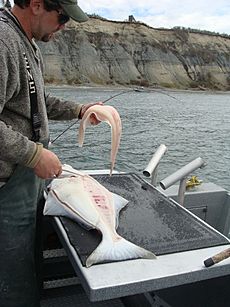
Not much farming happens in Alaska due to the cold climate and short growing season. Most farms are in the Matanuska-Susitna Valley or on the Kenai Peninsula. The main crops are potatoes, carrots, lettuce, and cabbage. The long sunny summer days help crops grow well.
Alaska has many state and local fairs in late summer. The Alaska State Fair in Palmer is the largest. Farmers show their produce there. "Alaska Grown" is a popular slogan for local farm products.
Alaska has a lot of seafood. The main fishing areas are in the Bering Sea and the North Pacific. Seafood is often cheaper in Alaska than outside the state. Many Alaskans fish for salmon to feed their families.
Hunting is also common, especially in remote areas. People hunt caribou, moose, and Dall sheep. A traditional Native food is Akutaq, which is Eskimo ice cream. It can be made from reindeer fat, seal oil, dried fish, and local berries.
Cities, Towns, and Boroughs

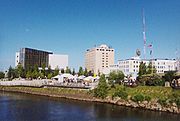
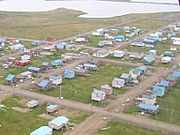
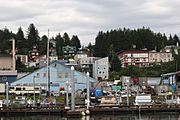

Alaska is not divided into counties like most other U.S. states. Instead, it is divided into boroughs. Many of the more populated parts of the state are in Alaska's 16 boroughs. These work like counties in other states. However, the boroughs do not cover all of Alaska's land. The area not in any borough is called the Unorganized Borough.
The Unorganized Borough has no government of its own. The U.S. Census Bureau divided it into 11 census areas. This was done only for collecting statistics.
Alaska's largest city is Anchorage. It had 278,700 people in 2006. Yakutat City, Sitka, Juneau, and Anchorage are among the largest cities in the U.S. by area.
Alaska's Culture and Traditions

Alaska has many popular annual events. One is the Iditarod Trail Sled Dog Race. It starts in Anchorage and ends in Nome. Other events include the World Ice Art Championships in Fairbanks. There is also the Blueberry Festival in Ketchikan. The Stikine River attracts the largest group of American bald eagles in the world during springtime.
The Alaska Native Heritage Center celebrates the rich history of Alaska's 11 cultural groups. It helps people learn about different cultures. The Alaska Native Arts Foundation helps sell Native art from all over the state.
Music in Alaska
Music in Alaska is influenced by traditional Alaska Native music. It also has folk music brought by people from Russia and Europe. Famous musicians from Alaska include singer Jewel. There is also traditional Aleut flautist Mary Youngblood.
Alaska has many music festivals. These include the Alaska Folk Festival and the Fairbanks Summer Arts Festival. The Anchorage Symphony Orchestra is the most famous orchestra in Alaska. The Anchorage Opera is the state's only professional opera company.
Learning in Alaska: Education
The Alaska Department of Education and Early Development manages many school districts in Alaska. The state also runs a boarding school, Mt. Edgecumbe High School in Sitka. It helps fund other boarding schools too.
There are more than a dozen colleges and universities in Alaska. These include the University of Alaska Anchorage, University of Alaska Fairbanks, and Alaska Pacific University. Alaska is the only state without any NCAA Division I sports teams.
The Alaska Department of Labor and Workforce Development runs AVTEC. This is Alaska's Institute of Technology. It offers short training programs in areas like welding and nursing.
Alaska has faced a "brain drain" problem. Many young people, especially top students, leave the state after high school. They often do not return. The University of Alaska tries to help with this. It offers scholarships to top Alaska high school graduates.
Getting Around: Transportation in Alaska
Roads in Alaska
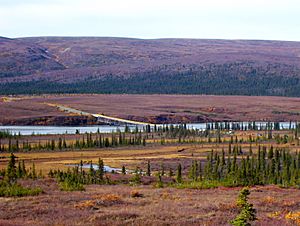
Alaska has few road connections compared to the rest of the U.S. The state's road system is small. It connects the main cities and the Alaska Highway. This highway is the main route out of the state through Canada. The state capital, Juneau, cannot be reached by road. You can only get there by ferry. The western part of Alaska has no roads connecting its communities to the rest of the state.
A unique part of Alaska's road system is the Anton Anderson Memorial Tunnel. This tunnel was originally for the Alaska Railroad. It was updated to allow cars to reach the town of Whittier. At 2.5 miles (4.0 km), it was the longest road tunnel in North America until 2007. It is the longest combined road and rail tunnel in North America.
Railroads in Alaska
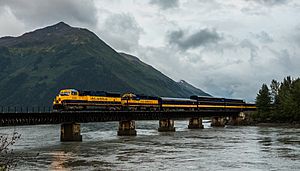
The Alaska Railroad (ARR) was built around 1915. It was very important for Alaska's growth in the 20th century. It connects shipping in the North Pacific to places like Anchorage, Fairbanks, and Seward. The areas served by the ARR are known as "The Railbelt."
The railroad helped move goods into Alaska. It also moved natural resources like coal and gravel out of Alaska. Today, it is well known for its summer passenger tours.
The Alaska Railroad was one of the last railroads in North America to use cabooses. It still uses them on some gravel trains. It also offers one of the last flag stop routes in the country. This means the train will stop anywhere along a certain stretch of track if someone flags it down.
The Alaska Rail network is not connected to the rest of North America.
Travel by Sea in Alaska
Many cities, towns, and villages in Alaska do not have roads. The only ways to get there are by air, river, or sea.
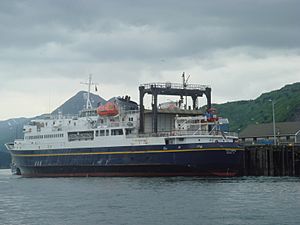
Alaska has a good state-owned ferry system called the Alaska Marine Highway. It serves cities in Southeast Alaska, the Gulf Coast, and the Alaska Peninsula. These ferries carry both vehicles and people. The system also runs a ferry service from Bellingham, Washington and Prince Rupert, British Columbia, in Canada.
In recent years, cruise lines have become popular for summer tourism. They mainly connect the Pacific Northwest to Southeast Alaska. The population of Ketchikan, for example, changes a lot on days when many cruise ships dock there.
Air Travel in Alaska
Cities not reached by road, sea, or river can only be reached by air, foot, dogsled, or snowmachine. This is why Alaska has so many bush air services. Ted Stevens Anchorage International Airport in Anchorage is served by many major airlines. Because there are few highways, air travel is the best way to get in and out of the state.
Regular flights to most villages are expensive to provide. So, the federal government helps pay for them through the Essential Air Service program. Alaska Airlines is the only major airline offering flights within the state with jet service.
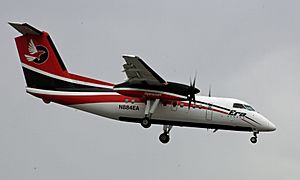
Smaller towns and villages rely on small regional airlines. They also use chartered bush flying services. These services use small planes like the Cessna Caravan. Many of these services are helped by the Alaska bypass mail program. This program pays for mail delivery to rural communities.
Many communities have small air taxi services. These services take people to remote areas. The most Alaskan plane might be the bush seaplane. The world's busiest seaplane base is Lake Hood. It is next to Ted Stevens Anchorage International Airport. Flights from here carry people and goods to remote villages without airstrips.
In 2006, Alaska had the highest number of pilots per person of any U.S. state.
Other Ways to Travel in Alaska
Another Alaskan way to travel is by dogsled. Today, dog mushing is more of a sport than a way to get around. Many races are held in the state. The most famous is the Iditarod Trail Sled Dog Race. This race is about 1,150-mile (1,850 km) long, from Anchorage to Nome. The race remembers the famous 1925 serum run to Nome. In that event, mushers and dogs like Togo and Balto carried medicine to Nome. This was needed when other ways of transport failed.
In areas without roads or rails, people use all-terrain vehicles in summer. In winter, they use snowmobiles, often called "snow machines" in Alaska.
Alaska's State Symbols
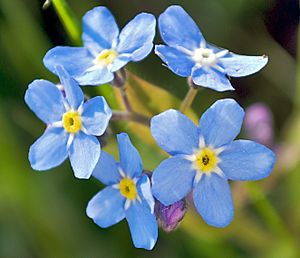
- State motto: North to the Future
- Nicknames: "The Last Frontier," "Land of the Midnight Sun," or "Seward's Icebox"
- State bird: willow ptarmigan, adopted in 1955. It is a small Arctic bird.
- State fish: king salmon, adopted 1962.
- State flower: wild/native forget-me-not, adopted in 1917. It grows all over Alaska.
- State fossil: woolly mammoth, adopted 1986.
- State gem: jade, adopted 1968.
- State insect: four-spot skimmer dragonfly, adopted 1995.
- State land mammal: moose, adopted 1998.
- State marine mammal: bowhead whale, adopted 1983.
- State mineral: gold, adopted 1968.
- State song: "Alaska's Flag"
- State sport: dog mushing, adopted 1972.
- State tree: Sitka spruce, adopted 1962.
- State dog: Alaskan Malamute, adopted 2010.
- State soil: Tanana, adopted unknown.
Images for kids
-
A modern Alutiiq dancer in traditional festival garb
-
The Russian settlement of St. Paul's Harbor (present-day Kodiak town), Kodiak Island, 1814
-
Miners and prospectors climb the Chilkoot Trail during the 1898 Klondike Gold Rush.
-
Although entirely east of the International Date Line (the triangular kink in the line was agreed upon the US acquisition of Alaska), the Aleutian Islands cross the 180th meridian, such that they contain both the westernmost (Amatignak) and the easternmost (Semisopochnoi.) points in the United States.
-
Fairbanks, Alaska's second-largest city and by a significant margin the largest city in Alaska's interior
-
Mask Display at Iñupiat Heritage Center in Utqiaġvik
See also
 In Spanish: Alaska para niños
In Spanish: Alaska para niños




